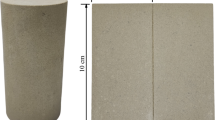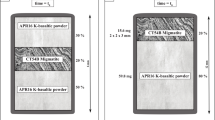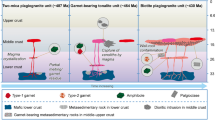Abstract
Seismic tomography observations have shown that there are two large low shear velocity provinces (LLSVPs) above the core-mantle boundary beneath Africa and the Pacific. The thermal and compositional properties of these two LLSVPs may differ from those of the ambient mantle, and they are suggested to be thermochemical piles of primordial material in the lower mantle. Their evolution is of great importance to our understanding of mantle dynamics. In this study, we systematically conducted numerical experiments to investigate the effects of the buoyancy ratio (B), compositional viscosity ratio \(\left( {\Delta {\eta _c}} \right)\), and heat-producing ratio (Λ) of the primordial material on the long-term evolution of thermochemical piles. Our results show that the buoyancy ratio plays the most important role in the stability of these piles. When the buoyancy ratio is small, and the primordial material is enriched in heat-producing elements (Λ>1), the stability of these piles decreases with increasing compositional viscosity ratio or heat-producing ratio. For cases with homogeneous heat production (Λ=1), the stability of these piles increases with increasing \(\Delta {\eta _c}\). We further compare constant internal heating with radioactive decay internal heating, and find that the long-term stability of thermochemical piles slightly decreases with radioactive decay heating, but the overall differences between these two internal heating modes are relatively small.
Similar content being viewed by others
References
Abbott D, Burgess L, Longhi J, Smith W H F. 1994. An empirical thermal history of the Earth’s upper mantle. J Geophys Res, 99: 13835–13850
Arevalo R, McDonough W F, Stracke A, Willbold M, Ireland T J, Walker R J. 2013. Simplified mantle architecture and distribution of radiogenic power. Geochem Geophys Geosyst, 14: 2265–2285
Ballmer M D, Houser C, Hernlund J W, Wentzcovitch R M, Hirose K. 2017. Persistence of strong silica-enriched domains in the Earth’s lower mantle. Nat Geosci, 10: 236–240
Brandenburg J P, Hauri E H, van Keken P E, Ballentine C J. 2008. A multiple-system study of the geochemical evolution of the mantle with force-balanced plates and thermochemical effects. Earth Planet Sci Lett, 276: 1–13
Citron R I, Lourenço D L, Wilson A J, Grima A G, Wipperfurth S A, Rudolph M L, Cottaar S, Montési L G J. 2020. Effects of heat-producing elements on the stability of deep mantle thermochemical piles. Geochem Geophys Geosyst, 21: e2019GC008895
Corgne A, Liebske C, Wood B J, Rubie D C, Frost D J. 2005. Silicate perovskite-melt partitioning of trace elements and geochemical signature of a deep perovskitic reservoir. Geochim Cosmochim Acta, 69: 485–496
Davaille A, Girard F, Le Bars M. 2002. How to anchor hotspots in a convecting mantle? Earth Planet Sci Lett, 203: 621–634
Davaille A. 1999. Simultaneous generation of hotspots and superswells by convection in a heterogeneous planetary mantle. Nature, 402: 756–760
Davies D R, Goes S, Davies J H, Schuberth B S A, Bunge H P, Ritsema J. 2012. Reconciling dynamic and seismic models of Earth’s lower mantle: The dominant role of thermal heterogeneity. Earth Planet Sci Lett, 353–354: 253–269
Davies D R, Goes S, Lau H C P. 2015. Thermally dominated deep mantle LLSVPs: A review. In: Khan A, Deschamps F, eds. The Earth’s Heterogeneous Mantle. Springer Geophysics. Cham: Springer. 441–477
Deschamps F, Tackley P J. 2008. Searching for models of thermo-chemical convection that explain probabilistic tomography: I. Principles and influence of rheological parameters. Phys Earth Planet Inter, 171: 357–373
Deschamps F, Tackley P J. 2009. Searching for models of thermo-chemical convection that explain probabilistic tomography. II—Influence of physical and compositional parameters. Phys Earth Planet Inter, 176: 1–18
French S W, Romanowicz B. 2015. Broad plumes rooted at the base of the Earth’s mantle beneath major hotspots. Nature, 525: 95–99
Frost D A, Garnero E J, Rost S. 2018. Dynamical links between small- and large-scale mantle heterogeneity: Seismological evidence. Earth Planet Sci Lett, 482: 135–146
Garnero E J, McNamara A K, Shim S H. 2016. Continent-sized anomalous zones with low seismic velocity at the base of Earth’s mantle. Nat Geosci, 9: 481–489
Gomi H, Ohta K, Hirose K, Labrosse S, Caracas R, Verstraete M J, Hernlund J W. 2013. The high conductivity of iron and thermal evolution of the Earth’s core. Phys Earth Planet Inter, 224: 88–103
Graham D W. 2002. Noble gas isotope geochemistry of mid-ocean ridge and ocean island basalts: Characterization of mantle source reservoirs. Rev Mineral Geochem, 47: 247–317
Grove T L, Parman S W. 2004. Thermal evolution of the Earth as recorded by komatiites. Earth Planet Sci Lett, 219: 173–187
He Y, Wen L. 2009. Structural features and shear-velocity structure of the “Pacific Anomaly”. J Geophys Res, 114: B02309
Herzberg C, Condie K, Korenaga J. 2010. Thermal history of the Earth and its petrological expression. Earth Planet Sci Lett, 292: 79–88
Heyn B H, Conrad C P, Trønnes R G. 2018. Stabilizing effect of compositional viscosity contrasts on thermochemical piles. Geophys Res Lett, 45: 7523–7532
Hofmann A W. 1997. Mantle geochemistry: The message from oceanic volcanism. Nature, 385: 219–229
Ishii M, Tromp J. 1999. Normal-mode and free-air gravity constraints on lateral variations in velocity and density of Earth’s mantle. Science, 285: 1231–1236
Kellogg L H, Hager B H, van der Hilst R D. 1999. Compositional stratification in the deep mantle. Science, 283: 1881–1884
Koelemeijer P, Deuss A, Ritsema J. 2017. Density structure of Earth’s lowermost mantle from stoneley mode splitting observations. Nat Commun, 8: 15241
Labrosse S, Hernlund J W, Coltice N. 2007. A crystallizing dense magma ocean at the base of the Earth’s mantle. Nature, 450: 866–869
Lau H C P, Mitrovica J X, Davis J L, Tromp J, Yang H Y, Al-Attar D. 2017. Tidal tomography constrains Earth’s deep-mantle buoyancy. Nature, 551: 321–326
Lee C T A, Luffi P, Höink T, Li J, Dasgupta R, Hernlund J. 2010. Upside-down differentiation and generation of a ‘primordial’ lower mantle. Nature, 463: 930–933
Li Y, Deschamps F, Tackley P J. 2014. The stability and structure of primordial reservoirs in the lower mantle: Insights from models of thermochemical convection in three-dimensional spherical geometry. Geophys J Int, 199: 914–930
Li Y, Deschamps F, Yang J, Chen L, Zhao L, Tackley P J. 2019. Effects of the compositional viscosity ratio on the long-term evolution of thermochemical reservoirs in the deep mantle. Geophys Res Lett, 46: 9591–9601
Masters G, Laske G, Bolton H, Dziewonski A. 2000. The relative behavior of shear velocity, bulk sound speed, and compressional velocity in the mantle: Implications for chemical and thermal structure. Earth’s Deep Interior: Mineral Physics and Tomography From the Atomic to the Global Scale, 117: 63–87
McDonough W F, Sun S. 1995. The composition of the Earth. Chem Geol, 120: 223–253
McNamara A K, Zhong S. 2004. Thermochemical structures within a spherical mantle: Superplumes or piles? J Geophys Res, 109: B07402
Mosca I, Cobden L, Deuss A, Ritsema J, Trampert J. 2012. Seismic and mineralogical structures of the lower mantle from probabilistic tomography. J Geophys Res, 117: B06304
Nakagawa T, Tackley P J. 2005. Deep mantle heat flow and thermal evolution of the Earth’s core in thermochemical multiphase models of mantle convection. Geochem Geophys Geosyst, 6: Q08003
Ni S, Tan E, Gurnis M, Helmberger D. 2002. Sharp sides to the African superplume. Science, 296: 1850–1852
Ricard Y, Richards M, Lithgow-Bertelloni C, Le Stunff Y. 1993. A geodynamic model of mantle density heterogeneity. J Geophys Res, 98: 21895–21909
Ritsema J, Deuss A, van Heijst H J, Woodhouse J H. 2011. S40RTS: A degree-40 shear-velocity model for the mantle from new Rayleigh wave dispersion, teleseismic traveltime and normal-mode splitting function measurements. Geophys J Int, 184: 1223–1236
Ritsema J, Ni S, Helmberger D V, Crotwell H P. 1998. Evidence for strong shear velocity reductions and velocity gradients in the lower mantle beneath Africa. Geophys Res Lett, 25: 4245–4248
Schuberth B S A, Bunge H P, Steinle-Neumann G, Moder C, Oeser J. 2009. Thermal versus elastic heterogeneity in high-resolution mantle circulation models with pyrolite composition: High plume excess temperatures in the lowermost mantle. Geochem Geophys Geosyst, 10: Q01W01
Solomatov V S, Stevenson D J. 1993. Suspension in convective layers and style of differentiation of a terrestrial magma ocean. J Geophys Res, 98: 5375–5390
Tackley P J, King S D. 2003. Testing the tracer ratio method for modeling active compositional fields in mantle convection simulations. Geochem Geophys Geosyst, 4: 8302
Tackley P J. 2008. Modelling compressible mantle convection with large viscosity contrasts in a three-dimensional spherical shell using the yin-yang grid. Phys Earth Planet Inter, 171: 7–18
Tkalčić H, Young M, Muir J B, Davies D R, Mattesini M. 2015. Strong, multi-scale heterogeneity in Earth’s lowermost mantle. Sci Rep, 5: 18416
Trampert J, Deschamps F, Resovsky J, Yuen D. 2004. Probabilistic tomography maps chemical heterogeneities throughout the lower mantle. Science, 306: 853–856
van Schmus W R. 1995. Natural radioactivity of the crust and mantle. In: Ahrens T J, ed. Global Earth Physics. A Handbook of Constants. Washington, DC: American Geophysical Union. 283–291
van Thienen P, van den Berg A P, Vlaar N J. 2004. On the formation of continental silicic melts in thermochemical mantle convection models: Implications for early Earth. Tectonophysics, 394: 111–124
van Thienen P, van Summeren J, van der Hilst R D, van den Berg A P, Vlaar N J. 2005. Numerical study of the origin and stability of chemically distinct reservoirs deep in Earth’s mantle. In: Van der Hilst R D, Bass J D, Matas J, Trampert J, eds. Earth’s Deep Mantle: Structure, Evolution and Composition. Geophysical Monograph Series. Washington, DC: American Geophysical Union. 160: 117–136
Yamazaki D, Karato S. 2001. Some mineral physics constraints on the rheology and geothermal structure of Earth’s lower mantle. Am Mineral, 86: 385–391
Acknowledgements
We thank Paul TACKLEY for providing the code StagYY. The calculations were performed on TianHe-1(A) cluster at National Supercomputer Center in Tianjin. This work was supported by the National Natural Science Foundation of China (Grant Nos. 41888101, 41625016), the International Partnership Program of Chinese Academy of Sciences (Grant No. 132A11KYSB20200019), the Innovation Group Project of Southern Marine Science and Engineering Guangdong Laboratory (Zhuhai) (Grant No. 311021003), the Key Research Program of the Institute of Geology and Geophysics CAS (Grant No. IGGCAS-201904), and the Pioneer Hundred Talents Program of Chinese Academy of Sciences.
Author information
Authors and Affiliations
Corresponding author
Electronic supplementary material
Rights and permissions
About this article
Cite this article
Huang, M., Li, Y. & Zhao, L. Effects of thermal, compositional and rheological properties on the long-term evolution of large thermochemical piles of primordial material in the deep mantle. Sci. China Earth Sci. 65, 2405–2416 (2022). https://doi.org/10.1007/s11430-021-9950-7
Received:
Revised:
Accepted:
Published:
Issue Date:
DOI: https://doi.org/10.1007/s11430-021-9950-7




